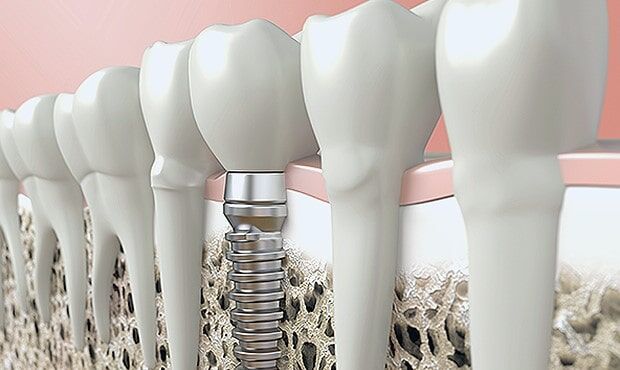Dental implants have been used for decades as a permanent, natural-looking alternative to dentures and bridges. However, to truly understand why dental implants are the gold standard of tooth replacement options, we need to take a closer look at each part of a dental implant. There are three main components have been widely used for decades and are trusted by most dentists, providing a reliable treatment outcome.
Dental implant components
The three main parts of most dental implants are the Fixture AKA implant post, abutment and crown.
Dental Implant Fixture
The fixture is a screw inserted into the jawbone during a short surgical procedure using advanced computer guided surgery. The actual fixture looks a little like the root of your tooth, which is precisely the way it’s designed, so if you see an implant post, you may notice its end is tapered just like a real tooth root.
Dental fixtures are available in a huge variety of different diameters, ensuring dentists can choose the most appropriate diameter for the tooth requiring restoration.
For example, a narrow diameter implant is more suited for smaller teeth such as incisors while a larger diameter is more suitable for larger teeth such as a molar. Dental implant posts also varies according to the size and location of the tooth to be replaced.
One the most used fixtures may be 18 mm in length, and for example, mini dental implants tend to have longer posts for greater strength and stability. A conventional dental fixture is hollow so that the abutment can be screwed onto the fixture.
A three-piece implant design allows the implant posts to be covered up for osseointegration, so it isn’t necessarily restored immediately with the prosthesis. Instead, the abutment is attached later when the implant dentist is ready to fabricate and fit the implant prosthesis.
Following the surgical placement of the implant, it will take approximately 4-6 months to heal before the next step in the dental implant process can begin.
Dental Implant Abutment
The abutment is a small connector piece that sits between the implant post and the prosthetic. One side is designed to screw into the inside of the implant post, while the other side is used to adhere a dental prosthetic. There are different types of abutments that may be used depending on the type of prosthetic that needs to be supported.
For example, a dental crown may simply look like a stumpy screw, while an abutment used for an implant-supported denture may have special attachments that can clip onto the denture. Some abutments can also be placed at different angles to ensure a natural appearance once the prosthetic is attached.
Depending on the technique used by your implant dentist, the abutment may be placed at the same time as the implant post or it may be screwed into the post after osseointegration has occurred.
Custom made abutments can be fabricated at the dental laboratory after an impression of the top of the implant is made with the adjacent teeth and gingiva. The size, shape and material depend on the patient’s needs and the location of teeth.
Dental Implant Prosthetic
The term prosthetic in most cases is used to refer to a limb replacement, usually an arm or a leg.
When it comes to dental implants, however, a prosthetic refers to an artificial tooth. By definition, a prosthetic is an artificial part of the body, and when you are discussing a dental implant prosthetic, you are referring to two different parts, the metal insert that connects to the jawbone and the actual tooth itself.
Prosthetic can be made from a variety of materials such as porcelain or ceramic, and it can either be screwed into place or cemented on the abutment.
Depending on the number of teeth being replaced you can have a prosthetic:
Crown:
dental crown will be attached to the abutment if a single tooth is being replaced. Dental crowns are typically ceramic, or a mixture of metal and porcelain. To create a natural looking tooth replacement, the crown will be is screwed or cemented onto the abutment.
Bridge:
If you are replacing a number of teeth in a row, a dental bridge may be used. Bridges are usually made from porcelain and are attached to just two implants which hold it securely in place. The artificial teeth in a dental bridge will be colour matched in order to blend in with the natural teeth.
Denture:
For patients who are replacing a full jaw of teeth, an implant supported denture can be used. Conventional dentures rest on the gums and are held in place by suction. Implant supported dentures are held securely in place with the help of dental implants. Implant supported dentures can give patients a natural looking smile. These dental restorations are typically made with either plastic or porcelain teeth attached to an acrylic base which is coloured to look like the natural gum line.
Final Thought
To sum up, dental implants represent the pinnacle of tooth replacement options, offering a permanent and natural-looking solution for those seeking to restore their smiles and oral function. By understanding the details of dental implant parts, patients can gain confidence in the effectiveness and reliability of this gold standard tooth replacement option.
With dental implants, patients can benefit from the precise customization of each component to suit their unique needs, ensuring optimal aesthetics, functionality, and durability. Whether replacing a single tooth with a crown, multiple teeth with a bridge, or a full jaw with an implant-supported denture, dental implants provide a reliable and long-lasting solution for tooth loss.
If you’re ready to explore the possibilities of dental implants and reclaim your confident smile and bite, we invite you to schedule a consultation with our experienced team. Contact us today at Mission Implant Center in Mission Viejo to take the first step towards a brighter, healthier future with dental implants. Your journey to renewed oral health and self-assurance awaits!

